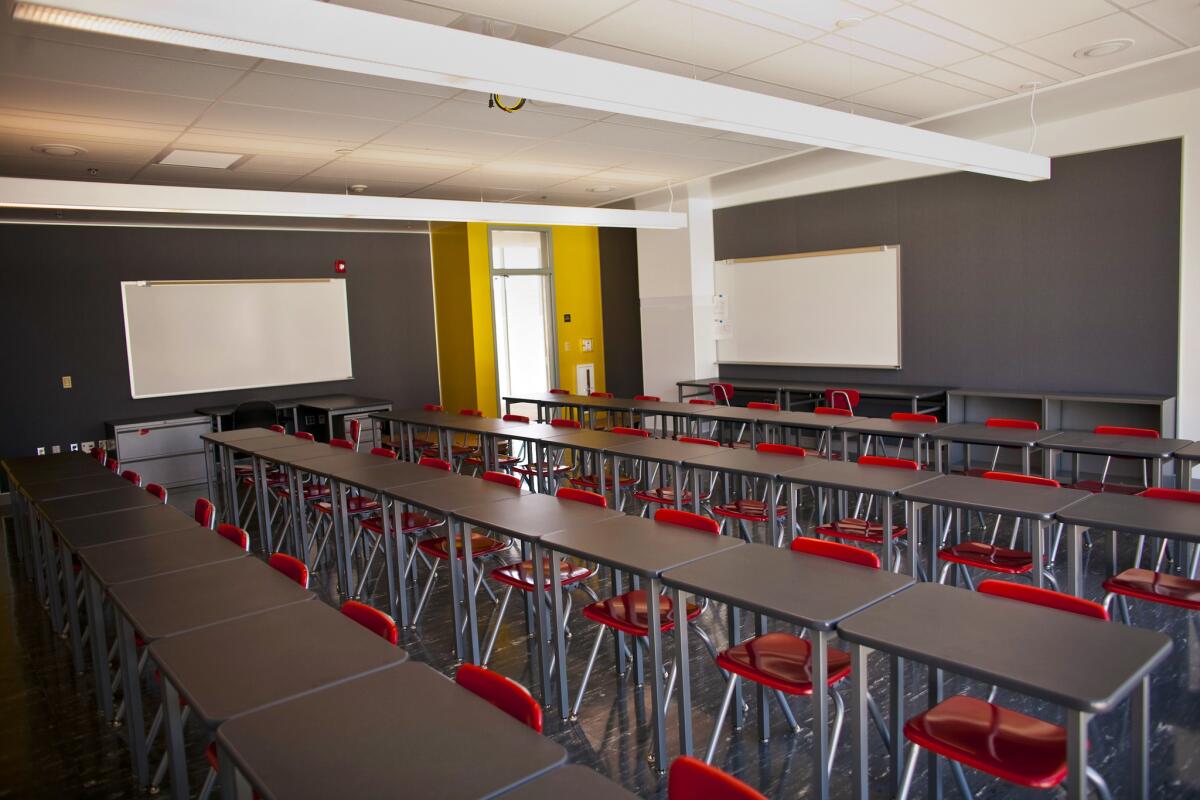Commentary: Coronavirus concerns ahead of the new school year

- Share via
Sally McBride (a fictional creation) was tired of Zoom, tired of parents and tired of not being with her kids alone in her classroom with that inexplicable feeling that teachers have for those 27 to 38 students in their rooms. Oh, for the freedom to tell that little inside joke, to walk among her students and put her hand lightly on the shoulder of the kid who was causing trouble and to actually teach with ease.
Instead Sally was going to have to walk into a classroom that reeked of Clorox and try to teach in two weeks. She tried to put away her fear. She felt strongly that if the district decided to have a semiregular school day, because she was comparatively young and healthy at 46, she had an obligation to do it. She was worried about her own health and worried about their one daughter who was slated to do a hybrid schedule in her district, which Sally hoped would keep her safer, but wasn’t at all sure.
She had a week to get ready, but one thing had never changed — meetings! Meetings were still scheduled, but in addition to those, there were new things to learn … always new things to learn. All summer there had been classes that Sally was asked to take, and much to her family’s dismay did take.
The district had stocked her room with hand sanitizer, soap, paper towels, Kleenex and trash containers, but as usual she could tell it wasn’t enough for even the first week. Sally anticipated many trips to the store. It was always hard getting supplies from the district anyway, and she knew that in these conditions, it would be even more difficult.
The signs were in the room also: “Wash your hands,” “Safe Distance 6 Feet,” “Use Sanitizer” and, oddly, “Don’t Touch!” She wasn’t sure what that last one meant, but it was funny. Going to Staples wasn’t as much fun as it used to be, but she knew that she was going to add to these small signs with much larger ones to make the point. She also knew that she was going to find cute but kind-of-scary photos to go with the signs and spend the requisite hours putting them on.
She had brought her blue tape to tape off the distancing of the forward-facing desks. She thought the district would probably do it, but she wasn’t sure. Things had continued to be confusing.
She wondered if the custodians would clean the books every day but knew that because she was now a freak about cleanliness that she would clean them anyway in between classes.
Sally looked at one of the two closets that would hold all the sanitizing stuff and reminded herself to bring a lock so that kids would not be able to get into what was going to be a toxic space.
Sally felt so sorry for the teachers who had the younger kids because it was going to be so hard to keep them safe. How were they going to keep kids wearing their masks correctly (they always somehow freed their nose, which was the place which was easily found by the virus), keep them apart, keep them from touching things, keep them from touching their faces, have them sanitize, wash their hands?
And then there was the whole bathroom scenario.
The bathroom issue was huge. No adult could go into the bathroom with a student or if a student was in there, so they were literally out of the educational community’s control in that one place. The only thing that could be controlled was rigorous viewing of the restroom door, so that only one child could go in at a time. Sally was not sure that was possible as the school only had two custodians currently. She was sure that teachers would be asked to fill in … and of course, they would.
She made a note to air that closet out every day. Could there be a toxic build up? She could see the closet exploding.
Speaking of airing, she wondered how she was going to increase ventilation as the windows were all on one side of the room. Well, not really … there were windows next to the ceiling but they were hard to open with the pole thing. Ventilation was important because she really didn’t want to use the air conditioner as the information about spreading the droplets was fairly clear in that A/C tended to spread and keep them up in the air. As Sally understood it, the best thing to do was let them drop to the ground and surfaces so they would either die or be sanitized.
For the last two months Sally had thought of the virus as having human qualities, and they weren’t good. They were killers. She had completely personified this virus, and she hated it with all her heart.
Yep, school was two whole weeks away … maybe. Sally was worried.
To be continued …
The writer is a Newport Beach resident who taught at the Newport-Mesa Unified School District for 40 years.
All the latest on Orange County from Orange County.
Get our free TimesOC newsletter.
You may occasionally receive promotional content from the Daily Pilot.



